The purpose of this study is to dispel some of the myths about Carbine Flash Hiders and to help interested individuals understand the history of their development and production. I have included pictures of all the US GI versions and some foreign ones too, but unfortunately the markings are very small and not heavily struck. Each photo has the actual marking duplicated in the caption. All research work comes from Ordnance Committee Memoranda, Ordnance Department historical documents, Technical Manuals, and by cataloging several hundred Flash Hiders over the last 20 years.
The T23 Is Born
The first requirement for a Flash Hider (FH) was in the fall of 1944. Aberdeen Proving Grounds (APG) was given the task of designing one based on the M1 Rifle’s existing cone flash hider. APG made six pilot models by removing the tubes from M8 Grenade Launchers (GL) and building upon their mounting brackets by adding a steel funnel. The result of the alterations were designated Hider, Flash, T23. The angle of the funnel was changed from the Garand’s due to line of sight interference caused by the Carbine’s different sights and sight radii. Like the Grenade Launcher the wing nut locking the T23 was in the top position mounted above the barrel.
Ordnance tested the ability of the T23 to prevent potential enemies from observing the shooter's flash. Observation tests were done at 25, 50, and 100 yards at 20 degrees from the line of fire. The tests were conducted at the Ordnance Research Center (ORC) using two of the six pilot models.
The tests were conducted with the following additional criteria:
- Ability to maintain accuracy with FH attached.
- Retention capability of the wing nut during recoil in semi and automatic fire.
- Further modifications to add the reduction of muzzle climb in automatic fire.
The T23 reduced observable flash by 95%. Test results showed no significant change in accuracy but serious problems with the wing nut. Operators had to keep their constant attention on the device, often having to retighten it after just 75 rounds. Field reports had shown minor problems with the M8 Grenade Launcher’s wing nut vibrating loose. This problem, although minor for the GL, represented a serious problem for the T23 as plans were being discussed to supply one for each T4 Carbine (M2).
Results also showed the design worked satisfactorily as a FH but altering its design to reduce muzzle climb was not practical. Each physical change that redirected gasses to reduce muzzle climb decreased the ability to hide the flash. The idea of combining the two functions was dropped. Later testing of the T12 and T13 Recoil Checks would lead to the post war adoption of the Recoil Check, M1. I will have a future article on the development of the M1 Recoil Check.
In early 1945 the Office, Chief of Engineers (OCE) requested the T23 be classified as limited procurement and requested one for evaluation. APG provided the Engineer Board with one of the pilot model T23's. The OCE was immediately impressed with its flash hiding capabilities and had 1700 manufactured for use with the M2 Sniperscope (Infrared). The M1 and M2 Sniperscopes along with the T3 Carbine are areas of research in themselves. The purpose of this writing is limited to Flash Hiders so I mention the above strictly for reference.
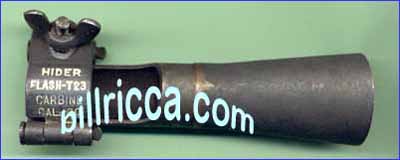
First Production T23 made for OCE. Marking: HIDER FLASH-T23 CARBINE CAL. -30
In the mid 1970's a company called Texas Armament made a very good reproduction of the above Flash Hider. Its markings were bold, correctly located, but differed in font size and overall construction. Texas Armament went so far as to even place the wing nut in the top position as was the case with all T23 FH's. It was so close that I would not recommend paying big money for one, unless you know how to distinguish both. If you know what to look for you can tell immediately. I will not go into the details otherwise internet hump artists will soon start a production line. I haven't been able to determine who made the T23 shown above. What is known is that it is was contracted by the Office, Chief of Engineers. All characteristics differ greatly from those known to be produced at Springfield Armory.
During this period of time two other designs were tested. The T23E1 and T23E2 were attached to the carbine with a bayonet type locking device. Both had problems with fitting as ordnance had recently allowed production of a stamped front sight to speed up production. This stamped sight had side walls that were made of steel that was thicker than earlier milled versions of the sight. That thicker steel interfered with the locking ability of the two designs. Since carbines were now in existence with the stamped front sights, the decision was made to drop both designs and no further consideration was given to either.
Springfield Armory and the T23
Springfield Armory had the responsibility to produce a small quantity of T23 Flash Hiders with nylon washer inserted in the wing nut, for further testing. The nylon washer was an attempt to solve the problem with the wing nut vibrating loose. Characteristics of Springfield Armory's T23 are different than any other T23. Throughout the years a few of these SA "Cigar Band" marked T23's have surfaced with two different markings. The existence of two markings can be something as significant as two different production runs, or something as simple as different tooling being used during production. A few of these hiders survived and got into use toward the end of the war on the M2 Sniperscope. The SA T23 has the wing nut mounted in the top position, a characteristic of all T23's except for one of the six pilot models that was eventually modified at the end of testing.
In April of 1945 some Springfield Armory T23's with the new wing nut and one of the original pilot models now designated T23 Modified with the new wing nut mounted below the barrel were delivered to the Infantry Board for testing. The wing nut had been moved below the barrel to prevent line of sight interference. This was the last change for the T23.
In the same month, April 1945, Headquarters, Army Ground Forces, based upon the tests at the Infantry Board recommended that the T23 Modified with the wing nut having a nylon washer inserted and having the wing nut mounted below the barrel (bottom position) be adopted for use with the M2 Carbine. Testing showed the nylon washer had provided enough resistance to prevent loosening. I quote from the Record of Army Ordnance Research and Development: “the basis of issue of this flash hider be one per Carbine, Caliber .30, T3 which is a part of the Sniperscope, M2, and one each to combat and combat support troops armed with the M2 Carbine”.
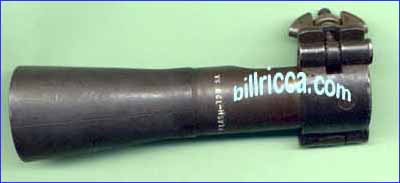 Cigar Band Type Markings of Springfield Armory's T23: Hider, Flash-T23 SA (Shown) Hider, Flash T-23 SA (not shown).
Cigar Band Type Markings of Springfield Armory's T23: Hider, Flash-T23 SA (Shown) Hider, Flash T-23 SA (not shown).
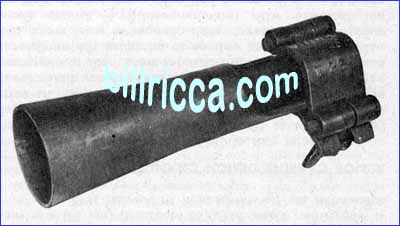 Photo of T23 Modified from Record of Army Ordnance Research and Development. Field use dictated the Wing Nut be moved to bottom position to prevent line of sight interference. Visible is hand stamped marking on this prototype, one of the six original APG pilot models, the only pilot model modified as such.
Photo of T23 Modified from Record of Army Ordnance Research and Development. Field use dictated the Wing Nut be moved to bottom position to prevent line of sight interference. Visible is hand stamped marking on this prototype, one of the six original APG pilot models, the only pilot model modified as such.
On 9 August of 1945 the T23 Modified with nylon washer inserted into the wing nut mounted below the barrel was recommended for standardization for the M2 Carbine as the Hider, Flash, M3. On 27 September 1945 the T23 Modified was approved for standardization for the M2 Carbine as the Hider, Flash, M3.
Post war things would change. The M1 Recoil Check eventually would be adopted and produced for the M2 Carbine. The M3 Flash Hider would be issued strictly with Infrared Sights.
The War In Korea and Production of the M3 Flash Hider
Soon after the Korean War started the Corps of Engineers, US Army developed and contracted for a new Infrared Sniperscope. The new item was designated Sniperscope, Infrared, Set No. 1, 20,000 Volts. With new technology available a new unit could be built with results of a better, more efficient sniper system.
In August 1951 two publications were rushed into print. TM 5-9341 covered the M1 and M2 Sniperscopes and superceded the same printing of September of 1944. TM 5-9342 was a new publication dealing with repair and maintenance for the new 20,000 Volt, Set No. 1. Both publications were titled Operation and Maintenance Instructions for....... the appropriate Infrared Scope(s). The illustrations in these two publications can give us an idea as to the timing of the Flash Hiders' production and availabilities. An examination of the publications shows that as of August 1951, the date both were published, the T23 was still in use, and most likely the M3 had not yet been fielded. The Engineer Branch of the US Army had responsibility for production of Infrared Sniperscopes, their tools, accessories, and publications. TM 5-9342 is quite specific in the types of tools and accessories for the 20,000 volt unit, but nowhere in the publication does it mention the M3 Flash Hider.
I have an SA marked M3 in an SA wrapper dated 26 March 1956, but that may not necessarily signify the production date. SA may have repacked the FH for storage shortly after the Korean War had ended, I don't know. I have seen no documentation as to when the two US GI Flash Hiders with M3 characteristics were produced. My guess is 1952-1953 for Underwood Corp, and Springfield Armory probably later. Whatever the case Springfield Armory M3's have always been available in lesser quantities than the Underwood Corp. M3's.
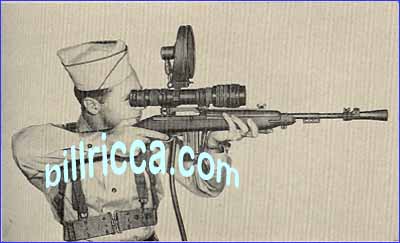 T23 in use on the M2 Sniper Scope, from TM 5-9341, Aug 51
T23 in use on the M2 Sniper Scope, from TM 5-9341, Aug 51
Note Flash Hider's Wing Nut in Top Position
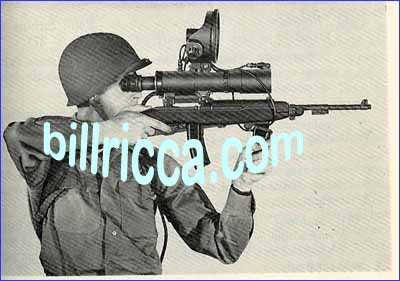 TM 5-9342 From the same month shows the newly adopted
TM 5-9342 From the same month shows the newly adopted
Set #1 (20,000 Volt) without Flash Hider. Production of
M3 Flash Hider was probably just beginning.
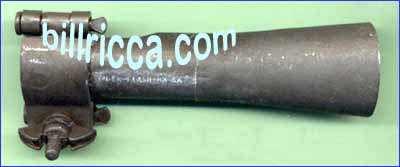 Springfield Armory's M3. Marking: Hider-Flash-M3-SA
Springfield Armory's M3. Marking: Hider-Flash-M3-SA
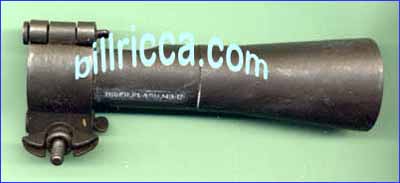 Underwood Corporation's M3. Marking:
Underwood Corporation's M3. Marking:
Hider, Flash, M3 · U · (pronounced dot you dot)
Sometime after the Korean War the Republic of South Korea produced their own Flash Hider. In 1996 Armscorp in Maryland imported a very large part of South Korea's spare parts inventory for the M1 Rifle and M1 Carbine. The owner, Mr. Jack Friese, was nice enough to allow me to go through his large inventory of recently imported US GI Carbine Flash Hiders. I was looking for a T23 but unfortunately none were there. I did find this TM marked Korean made Flash Hider among the many hundreds I inspected. The quality is identical to the two American made flash hiders. I have not seen many of these.
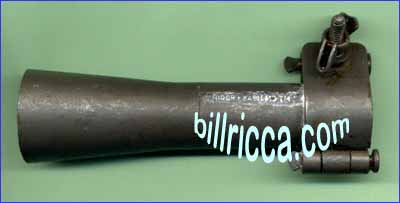 South Korean Production. Marking: Hider Flash M3 TM
South Korean Production. Marking: Hider Flash M3 TM
A short time later another high quality Flash Hider was brought into the country. Immediate ads appeared listing it as "WW II US GI". The quality is just like the US models, but it is not US, and definitely not WWII. Message boards have claimed its origin as being Belgium, NATO Forces, Italy, and The Phillipines. To date nobody can provide proof for any of the claims as to its origin, but it is a high quality Flash Hider reasonably priced and easily found. The markings have the same marking as found on a 1956 Garand barrel, the letter F in an oval. No such flash hider has ever been found in a wrapper that can be identified as US or in an infrared set #1. One characteristic that differs is that all the US Flash Hiders have heavy stamped steel wing nuts; this Flash Hider has a cast aluminum wing nut. I refer to it as the Oval F Flash Hider. A good FH for somebody that does not want to spend a lot of money. A lot of quality for small money.
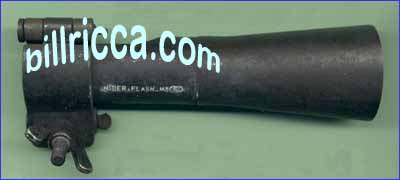
Oval F Markings: HIDER. FLASH.M3![]()
The Flash Hider for the M1 Carbine is probably the most popular accessory on the market. Watch any new owner who just bought his first M1 Carbine and one the first items he seeks is a Flash Hider. Kids too young to own a carbine are mesmerized by the sight of an M1 Carbine sporting a Flash Hider. There is something about it that appeals to the curious new guy and the advanced collector. The demand has been so consistent that reproductions have been produced since the late 1960's. Go out, find one for sale, buy it and enjoy it. Your carbine will look nicer and your friends will be impressed.
Sources and Summary
- All information is from summaries of Ordnance Committee Memoranda, inspection of Flash Hider wrappings, and inspecting close to 600 M3 Flash Hiders. Some information is from a now departed gentleman who worked at Rock Island Arsenal and had access to some of the Infrared Sniperscopes in storage there. After looking for months he found no T23's in storage. The only information he was able to report was the existence of the M3's produced by Underwood and Springfield Armory but he did find one that was unmarked (production error). He died around 1978 and I wish I could remember his name. I would like to credit him for his help. I also wish to thank Mr. Jack Friese for allowing me access to his inventory of M3 Flash Hiders in 1996/97.
- All T23's shown here have at least one identifying characteristic withheld. Those who want to commit fraud will have the futile chore of finding an original to copy.
- As far as availability, the following unscientific fact will give you an idea of the T23's. I have seen approx. 15 OCE T23's in private hands. I know of the existence of 4 SA T23's in private hands. Keep in mind the Texas Armament T23 looks very much like the OCE T23 but I am not counting those. I do not know how many Springfield T23's were made or still exist but they are the scarcest of all the US GI Carbine Flash Hiders (excluding the pilot models). My guess is Springfield T23's were made in small quantities, just enough for testing at various Boards. Remember some did get used with Infrared Sights.
- How many M3's were made? I know of no documentation found showing production numbers. Sam Bases, an electrical engineer who has worked on all three types of Carbine Infrared Sights over the last 40 years estimates that 15,000-20,000 Sets #1 were produced (20,000 volt). Sam's guess is based upon observed serial numbers. I would guess at least one M3 was produced for each set. I thank Sam for his input on Infrared Sights, he is a wealth of knowledge.
- As far as availability of the M3, the Springfield Armory M3 was obviously made in lesser amounts than the Underwood. The Korean TM is quite scarce, but now with more eyes looking I am sure some will turn up. The Oval F is often found on eBay, in The Shotgun News, on Websites and at gun shows. There are reports that the Oval F M3 is now being reproduced, but I have no knowledge by who or how it differs. The same Oval F marking has been found on M1 Recoil Checks. I will write about those in the future; there is something fishy about the ones I have found.
- I have had two reports that an internet seller who was exposed for advertising the Garand T37 Flash Hiders (Cast in Taiwan) as US GI is currently offering FH's with a description of "Authentic WWII U.S. Mil." and sending out reproductions produced from castings. See Illustration below.
- Reproductions are marked "Hider, Flash, Spain" and "Hider, Flash-M3" with no manufacturer marks. Both types are castings. All US GI FH's are a combination of machining and heavy stampings held together with a variety of welds or brazing. The reproduction from Spain has a light stamped wing nut with no nylon washer and loosens when fired. The other reproduction I inspected had a cast aluminum wing nut missing the nylon lock.
- Despite not being what most people think it is (WWII, M1 Carbine), it is still a beautifully made piece of carbine history.
- UPDATED June 2004: A website from Korea dealing with Military Armaments sent over from the US states that according to US records 2100 T23 Flash Hiders were produced. The site covers the early days of the Korean War and the shortage of Flash Hiders for the M2 Infra Red sights. The quantity of 2100 makes sense. With 1700 produced by OCE the resulting SA production would be 400. The ratio of approx 4 to 1 works out based upon the confirmed surviving quantities stated in #3 above. That number 2100 also comes very close to the total quantity of T3 Carbines produced. The T3 was the original carbine designed to accommodate the M2 Sniper Scope.
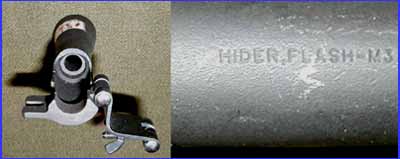
Left: Examination of current reproduction shows the locking bracket is attached to a body and funnel which are cast as a unit. All military production is heavy stampings held together with welds.
Right: Marking of current reproduction.
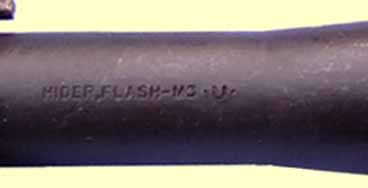
This recently was offered on eBay. It is an attempt to fake the Underwood Flash Hider. Notice it is a solid casting and is missing the welded or brazed "funnel", as all US GI have. It also has the wrong wing nut, similar to the one used on the cast flash hider in the above illustration. According to the eBay sale, the seller makes no claims as to authenticity, offers no refunds, and requires money orders only. Notice the markings are incorrect also, there is not dash used on the Underwood Flash Hider. The individual responsible for this has very little knowledge of what he fakes. It has become an amusing game to watch him make mistakes. Fake flash hiders are just the beginning of a long line of fake products he offers on a regular basis, on eBay. Carbine barrels with WWII markings, marked magazine catches, flip sights with bogus markings, and push button safeties are all part of his product line of fakes.
This flash hider, without his handiwork, sells on internet sites for approximately $22.00.
This page will be updated as more information is uncovered. Return here often.
This information may be used freely for message boards discussions. Permission must be granted for use on websites, for publication, or for inter-net auctions. Don't be afraid to ask, you may be surprised.
All inquiries regarding this research project must be by email.

